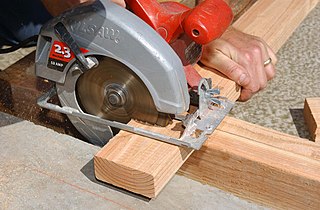
A circular saw is a power-saw using a toothed or abrasive disc or blade to cut different materials using a rotary motion spinning around an arbor. A hole saw and ring saw also use a rotary motion but are different from a circular saw. Circular saws may also be loosely used for the blade itself. Circular saws were invented in the late 18th century and were in common use in sawmills in the United States by the middle of the 19th century.
A saw is a tool consisting of a tough blade, wire, or chain with a hard toothed edge used to cut through material. Various terms are used to describe toothed and abrasive saws.

A chainsaw is a saw that cuts with a set of teeth attached to a rotating chain driven along a guide bar. Modern chainsaws are is used in activities such as tree felling, limbing, bucking, pruning, cutting firebreaks in wildland fire suppression, harvesting of firewood, for use in chainsaw art and chainsaw mills, for cutting concrete, and cutting ice. Precursors to modern chainsaws were first used in surgery, with patents for wood chainsaws beginning in the late 19th century.
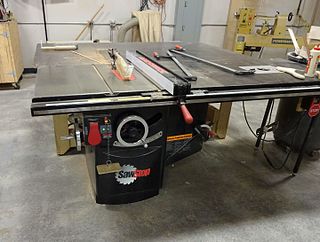
A table saw is a woodworking tool, consisting of a circular saw blade, mounted on an arbor, that is driven by an electric motor. The blade protrudes through the top of a table, which provides support for the material, usually wood, being cut.

In woodworking, a rip-cut is a type of cut that severs or divides a piece of wood parallel to the grain. The other typical type of cut is a cross-cut, a cut perpendicular to the grain. Unlike cross-cutting, which shears the wood fibers, a rip saw works more like a series of chisels, lifting off small splinters of wood. The nature of the wood grain requires the shape of the saw teeth to be different thus the need for both rip saws and crosscut saws; however some circular saw blades are combination blades and can make both types of cuts. A rip cut is the fundamental type of cut made at a sawmill.
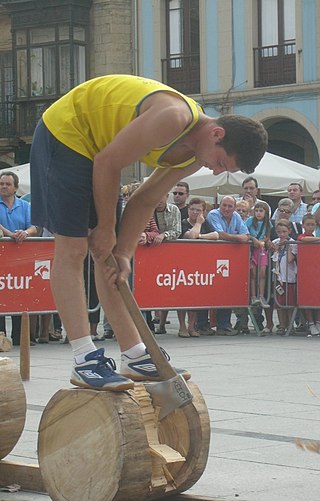
Woodsman is a competitive, co-ed intercollegiate sport in the United States, Canada and elsewhere based on various skills traditionally part of forestry educational and technical training programs. In North America, the sport currently is organized in five regional divisions: northeastern, mid-Atlantic, southern, midwestern, and western.

A radial arm saw is a cutting machine consisting of a circular saw mounted on a sliding horizontal arm. Invented by Raymond DeWalt in 1922, the radial arm saw was the primary tool used for cutting long pieces of stock to length until the introduction of the power miter saw in the 1970s.
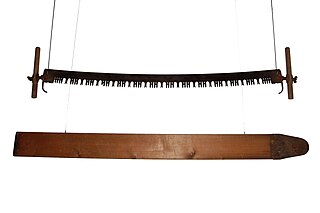
A crosscut saw is any saw designed for cutting wood perpendicular to (across) the wood grain. Crosscut saws may be small or large, with small teeth close together for fine work like woodworking or large for coarse work like log bucking, and can be a hand tool or power tool.

A miter saw or mitre saw is a saw used to make accurate crosscuts and miters in a workpiece by positioning a mounted blade onto a board. A miter saw in its earliest form was composed of a back saw in a miter box, but in modern implementation consists of a powered circular saw that can be positioned at a variety of angles and lowered onto a board positioned against a backstop called the fence.

A two-man saw is a saw designed for use by two sawyers. While some modern chainsaws are so large that they require two persons to control, two-man crosscut saws were primarily important when human power was used. Such a saw would typically be 1 to 4 m long, and sometimes up to 5 m, with a handle at each end. In some cases, such as when felling Giant Sequoias, sawblades could be brazed together end-to-end in order to create longer saws.

A bucksaw is a hand-powered frame saw similar to bow saw and generally used with a sawbuck to cut logs or firewood to length (bucking). Modern bucksaws usually have a metal frame and a removable blade with coarse teeth held in tension by the frame. Lightweight portable or foldable models used for camping or back-packing are also available. It is often referred to as a bow saw in the North American hardware market, but that term traditionally refers to a different type of saw with a wooden frame.

Japanese carpentry was developed more than a millennium ago through Chinese architectural influences from the 12th century. It is a form of ancient Chinese wooden architecture and woodworking joints that involves building wooden furniture without the use of nails, screws, glue, or electric tools.

Wood shingles are thin, tapered pieces of wood primarily used to cover roofs and walls of buildings to protect them from the weather. Historically shingles, also known as shakes, were split from straight grained, knot free bolts of wood. Today shingles are mostly made by being cut which distinguishes them from shakes, which are made by being split out of a bolt.

A billhook or bill hook, also called a pruning knife or spar hook, is a versatile cutting tool used widely in agriculture and forestry for cutting woody material such as shrubs, small trees and branches. It is distinct from the sickle. It was commonly used in Europe with an important variety of traditional local patterns. Elsewhere, it was also developed locally such as in the Indian subcontinent, or introduced regionally as in the Americas, South Africa, and Oceania by European settlers.

Bucking is the process of cutting a felled and delimbed tree into logs. Significant value can be lost by sub-optimal bucking because logs destined for plywood, lumber, and pulp each have their own value and specifications for length, diameter, and defects. Cutting from the top down is overbucking and from the bottom up is underbucking.

A dragsaw or drag saw is a large reciprocating saw using a long steel crosscut saw to buck logs to length. Prior to the popularization of the chainsaw during World War II, the dragsaw was a popular means of taking the hard work out of cutting wood. They would only work for a log on the ground. Dragsaws are known as the first mechanical saws to be used in the timber industry operation. These tools were most useful in the logging business, because they were efficient and very resilient. Not to be confused with a steam donkey.
This glossary of woodworking lists a number of specialized terms and concepts used in woodworking, carpentry, and related disciplines.

An axe is an implement that has been used for millennia to shape, split, and cut wood, to harvest timber, as a weapon, and as a ceremonial or heraldic symbol. The axe has many forms and specialised uses but generally consists of an axe head with a handle, also called a haft or a helve.
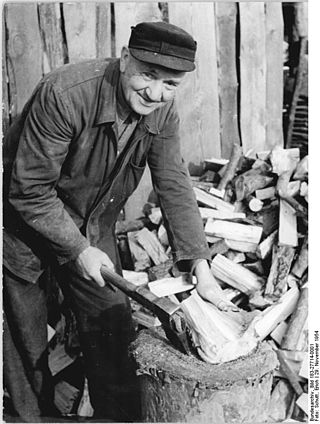
A cleaving axe or cleaver is a form of axe used within green woodworking to split wood lengthways. Cleaving (riving) is used to turn a log into lumber or billets into firewood. Splitting axe is sometimes described as an old name for a splitting maul or froe.

















